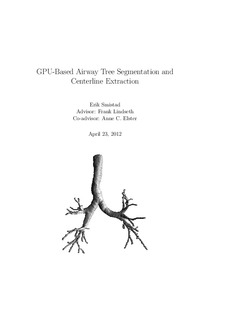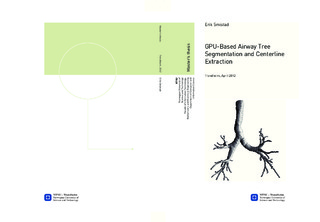| dc.contributor.advisor | Lindseth, Frank | nb_NO |
| dc.contributor.advisor | Elster, Anne C. | nb_NO |
| dc.contributor.author | Smistad, Erik | nb_NO |
| dc.date.accessioned | 2014-12-19T13:38:34Z | |
| dc.date.available | 2014-12-19T13:38:34Z | |
| dc.date.created | 2012-11-08 | nb_NO |
| dc.date.issued | 2012 | nb_NO |
| dc.identifier | 565858 | nb_NO |
| dc.identifier | ntnudaim:6751 | nb_NO |
| dc.identifier.uri | http://hdl.handle.net/11250/252887 | |
| dc.description.abstract | Lung cancer is one of the deadliest and most common types of cancer inNorway. Early and precise diagnosis is crucial for improving the survivalrate. Diagnosis is often done by extracting a tissue sample in the lung throughthe mouth and throat. It is difficult to navigate to the tissue because of thecomplexity of the airways inside the lung and the reduced visibility. Our goalis to make a program that can automatically extract a map of the Airwaysdirectly from X-ray Computer Tomography(CT) images of the patient. Thisis a complex task and requires time consuming processing.In this thesis we explore different methods for extracting the Airways fromCT images. We also investigate parallel processing and the usage of moderngraphic processing units for speeding up the computations. We rate severalmethods in terms of reported performance and the possibility of parallelprocessing. The best rated method is implemented in a parallel frameworkcalled Open Computing Language.The results shows that our implementation is able to extract large parts ofthe Airway Tree, but struggles with the smaller airways and airways thatdeviate from a perfect circular cross-section. Our implementation is ableto process a full CT scan using less than a minute with a modern graphicprocessing units. The implementation is very general and is able to extractother tubular structures as well. To show this we also run our implementationon a Magnetic Resonance Angio dataset for finding blood vessels in the brainand achieve good results.We see a lot of potential in this method for extracting tubular structures. Themethod struggles the most with noise handling and tubes that deviate froma circular cross-sectional shape. We believe that this can be improved byusing another method than ridge traversal for the centerline extraction step.Because this is a local greedy algorithm, it often terminates prematurely dueto noise and other image artifacts. | nb_NO |
| dc.language | eng | nb_NO |
| dc.publisher | Institutt for datateknikk og informasjonsvitenskap | nb_NO |
| dc.subject | ntnudaim:6751 | no_NO |
| dc.subject | MTDT datateknikk | no_NO |
| dc.subject | Intelligente systemer | no_NO |
| dc.title | GPU-Based Airway Tree Segmentation and Centerline Extraction | nb_NO |
| dc.type | Master thesis | nb_NO |
| dc.source.pagenumber | 101 | nb_NO |
| dc.contributor.department | Norges teknisk-naturvitenskapelige universitet, Fakultet for informasjonsteknologi, matematikk og elektroteknikk, Institutt for datateknikk og informasjonsvitenskap | nb_NO |

